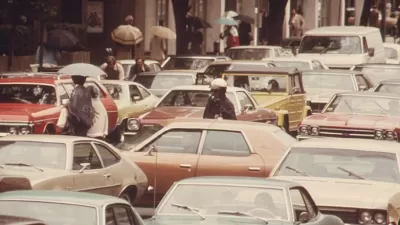The Federal Highway Administration has quietly acknowledged the end of the Driving Boom, cutting its VMT forecast by 24-44 percent. This represents a major change in travel forecasting and planning.

The Federal Highway Administration (FHWA) has very quietly acknowledged that the Driving Boom is over, cutting its forecasted driving estimates by between 24 percent and 44 percent.
After many years of inaccurately claiming that Americans would likely begin a new era of increased driving, the agency's latest forecast finally recognizes that the Driving Boom has given way to decades of far slower growth. The amount that the average American drove actually declined nearly 9 percent between 2004 and 2014, resulting in about a half trillion fewer total miles driven in 2014 than if driving had continued to increase at earlier rates.
The new forecast is a major departure from the FHWA's past record. An analysis of these projections showed that the Department of Transportation (USDOT) had issued 61 driving forecasts in a row that overshot their mark. The new forecast suggests that driving per-person will essentially remain flat. The benchmark is important because exaggerated estimates of future driving are used to justify wasteful spending on new and wider highways. Meanwhile, policymakers pay little attention to repairing existing roads, and don't invest enough in other modes of travel.
"The agency plays the vital role of guiding decisions for future infrastructure investment," said Phineas Baxandall, Senior Analyst at the U.S. Public Interest Research Group (U.S. PIRG). "By recognizing changing travel behavior and the preferences of a rising Millennial generation, America can avoid billions in unnecessary spending for additional highway capacity that shouldn't be a priority."
The baseline forecast of total driving miles shows an increase of only 0.75 percent annually during the period from 2012 to 2042, with population growth averaging 0.7 percent each year - thus leaving driving miles per-person essentially flat. According to the FHWA report, "This represents a significant slowdown from the growth in total VMT experienced over the past 30 years, which averaged 2.08% annually."
Gabe Klein, former Department of Transportation Director of both Chicago (CDOT) and Washington D.C. (DDOT), commented, "I know from experience these forecasts have great importance in shaping debates and policy on every level of transportation funding. USDOT is clearly stating that a broad-based policy of building more road capacity for cars is not fiscally responsible or what the public needs or wants."
Until now, there had not been a major reconsideration of past methods, which have chiefly depended on aggregating forecasts issued by states that are seeking federal funding for highway expansion projects. The significance of the new estimates is apparent by comparing them with the agency's Conditions and Performance Report to Congress, which estimated that total vehicle miles traveled (VMT) will increase an average of between 1.36 percent to 1.85 percent each year through 2030. This raised some eyebrows, because total annual VMT hasn't increased by even as much as 1 percent in any year since 2004. Comparing the 20-year estimates of the Conditions and Performance Report with the new 20-year estimates shows the agency has cut its forecasted growth rate between 24 and 44 percent.

The American Association of Highway and Transportation Officials (AASHTO) also incorporated lower-bound growth estimates in it's recent Bottom Line Report, which projects transportation investment requirements.
FULL STORY: Federal Highway Administration Quietly Acknowledges the Driving Boom is Over

Planetizen Federal Action Tracker
A weekly monitor of how Trump’s orders and actions are impacting planners and planning in America.

Chicago’s Ghost Rails
Just beneath the surface of the modern city lie the remnants of its expansive early 20th-century streetcar system.

San Antonio and Austin are Fusing Into one Massive Megaregion
The region spanning the two central Texas cities is growing fast, posing challenges for local infrastructure and water supplies.

Since Zion's Shuttles Went Electric “The Smog is Gone”
Visitors to Zion National Park can enjoy the canyon via the nation’s first fully electric park shuttle system.

Trump Distributing DOT Safety Funds at 1/10 Rate of Biden
Funds for Safe Streets and other transportation safety and equity programs are being held up by administrative reviews and conflicts with the Trump administration’s priorities.

German Cities Subsidize Taxis for Women Amid Wave of Violence
Free or low-cost taxi rides can help women navigate cities more safely, but critics say the programs don't address the root causes of violence against women.
Urban Design for Planners 1: Software Tools
This six-course series explores essential urban design concepts using open source software and equips planners with the tools they need to participate fully in the urban design process.
Planning for Universal Design
Learn the tools for implementing Universal Design in planning regulations.
planning NEXT
Appalachian Highlands Housing Partners
Mpact (founded as Rail~Volution)
City of Camden Redevelopment Agency
City of Astoria
City of Portland
City of Laramie





























